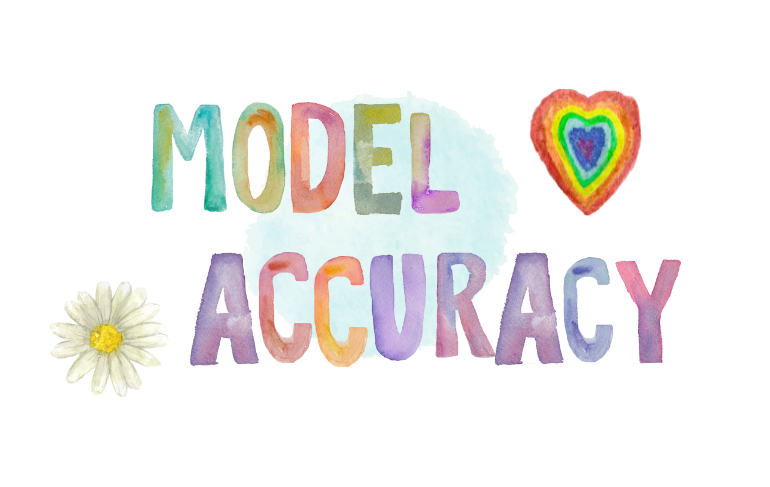
Section 3 Assessing Model Accuracy

"There is no free lunch in statistics"
No one method dominates all others over all possible data sets. This section introduce some common ways to assess the accuracy of a model to select a statistical learning procedure for a specific data set.
3.1 The Regression Setting
3.1.1 Measuring the Quality of fit
In order to evaluate the performance of a model, we need to measure how well its predictions actually match the observed data. In the regression setting, the most commonly used measure is the mean squared error (MSE). MSE is the average squared difference between the estimated values and the actual value. The MSE formula illustrated in (3.1):
\[\begin{equation} \Large MSE = \frac{1}{n}\sum_{i = 1}^{n} (y_{n} - \hat{f}(x_{i})^2 \tag{3.1} \end{equation}\]
given by where \(\hat{f}(x_{i}\) is the prediction that \(\hat{f}\) gives for the \(i\)th observations.
The MSE will be small if the predicted responses are very close to the true response, and will be large if for some observations, the predicted and true responses differ substantially.
Training MSE
computed using the training data that was used to fit the model.
Test MSE
computed using the previously unseen test observation not used to train the statistical learning method.
When a given method yields a small training MSE but a large test MSE, we are said to be overfitting the data. When we overfit the training data, the test MSE will be very large because the supposed patterns that the method found in the training data simply don’t exist in the test data.
3.2 The Bias-Variance Trade-Off
3.2.1 Variance Error
Variance is the amount that the estimate of \(\hat{f}\) will change if different training data was used.
Ideally, it should not change too much from one training dataset to the next, meaning that the algorithm is good at picking out the hidden underlying mapping between the inputs and the output variables.
Examples of low-variance machine learning algorithms include: Linear Regression, Linear Discriminant Analysis and Logistic Regression.
Examples of high-variance machine learning algorithms include: Decision Trees, k-Nearest Neighbors and Support Vector Machines.
3.2.2 Bias Error
Bias are the simplifying assumptions made by a model to make the target function easier to learn.
Generally, linear algorithms have a high bias making them fast to learn and easier to understand but generally less flexible. In turn, they have lower predictive performance on complex problems that fail to meet the simplifying assumptions of the algorithms bias.
Low Bias
Suggests less assumptions about the form of the target function.
High-Bias
Suggests more assumptions about the form of the target function.
Examples of low-bias machine learning algorithms include: Decision Trees, k-Nearest Neighbors and Support Vector Machines.
Examples of high-bias machine learning algorithms include: Linear Regression, Linear Discriminant Analysis and Logistic Regression.
3.2.3 Bias-Variance Trafe-Off
The goal of any supervised machine learning algorithm is to achieve low bias and low variance. In turn the algorithm should achieve good prediction performance.
- Linear machine learning algorithms often have a high bias but a low variance.
- Nonlinear machine learning algorithms often have a low bias but a high variance.
- The parameterization of machine learning algorithms is often a battle to balance out bias and variance.
3.3 The Classification Setting
The most common approach for quantifying the accuracy of our estimate \(\hat{f}\) is the training error rate, the proportion of mistakes that are made if we apply our estimate \(\hat{f}\) to the training observations:
\[\begin{equation} \frac{1}{n}\sum_{i = 1}^{n} I (y_{i} \neq \hat{y_{i}}) \tag{3.2} \end{equation}\]
Whereas:
\(\hat{y_{i}}\): the predicted class label for the \(i\)th observation using \(\hat{f}\)
\(I (y_{i} \neq \hat{y_{i}})\): an indicator variable that equal 1 if \(y_{i} \neq \hat{y_{i}}\) and 0 if \(y_{i} = \hat{y_{i}}\). If:
\(I (y_{i} \neq \hat{y_{i}}) = 0\): correct classification
\(I (y_{i} \neq \hat{y_{i}}) \neq 0\): incorrect classification (misclassified)
A good classifier is one for which the test error is smallest where the test error rate associated with a set of test observations of the from \((x_{0}, y_{0})\).
3.3.1 The Bayes Classifier
This algorithm is called Naïve because it works on the naïve assumption that the features are independent. Naïve Bayes Classifier works with principle of Bayes Theorem.
Conditional probability of an event \(A\) given \(B\), \(P(A|B)\) is the probability of \(A\) given that \(B\) has already occurred. It is often defined as the ratio of joint probability of \(A\) and \(B\) (probability of \(A\) and \(B\) occurring together) to the marginal probability of \(A\) (probability of event \(A\))
Pros
- Easy to implement
- Performs reasonably well with noisy data
Cons
- Poor performance with continuous features
- Assumption that features are independent is risky
3.3.2 K-Nearest Neighbors (KNN)
K-Nearest neighbors (KNN) algorithm can be used to solve both classification and regression problems. When algorithms such as Naïve Bayes Classifier uses probabilities from training samples for predictions, KNN is Lazy learner that does not create any model in advance. The just find the closest based on feature similarity.
Pros
- Easy to implement
- No assumptions involved
Cons
- Optimal K is always a challenge
- Lazy learner- computationally expensive